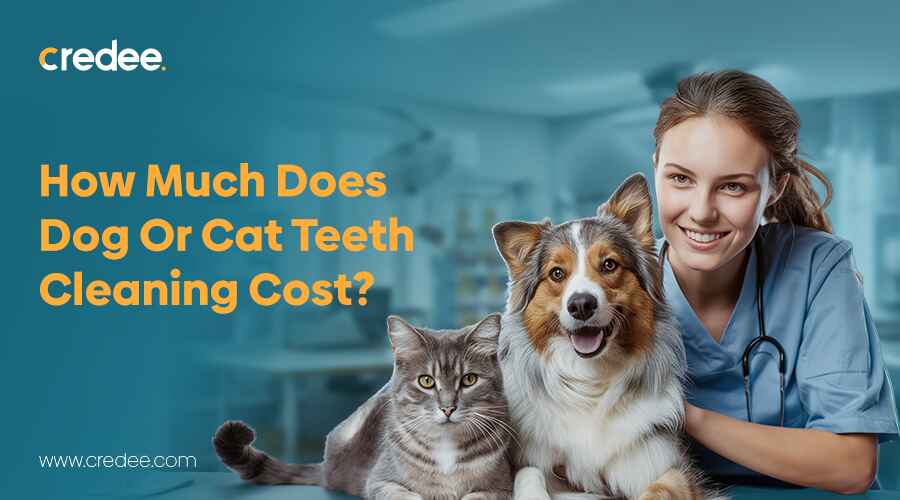
As a responsible pet parent, you research and get your dog or cat the best food. You make sure their fur is always clean and they’re well-groomed. And vet appointments? You never miss one. You think there’s nothing to worry about. They seem perfectly healthy, right?
But there might be one thing you’re missing. Underneath that cute, grateful smile, plaque can start to build up, just like it does for us. Simply because you didn’t think of it. Over time, that sticky layer hardens into tartar, pushing against the gums and letting bacteria sneak in.
What starts as a bit of bad breath can turn into gum infection, loose teeth, and pain every time they eat. In severe cases, that infection can travel through the bloodstream and affect their heart, liver, or kidneys, all from what looked like “just dirty teeth.”
A typical teeth cleaning costs around $300 to $500 for a basic job by a general vet in the U.S.
Before we get into the details, here’s a telling stat: the U.S. pet dental health services market was valued at over $2 billion in 2023 and continues to grow steadily each year.
So yes, dental cleaning for your pet isn’t “going the extra mile”, it’s basic care. And knowing what to expect cost-wise means you won’t be caught off guard.
Why Pet Dental Care Matters?
Dental care might start with fresh breath and clean teeth, but it goes much further. Plaque and tartar build up just like in humans. If unchecked, that leads to gum disease, tooth loss, and worse, bacteria in the mouth can travel and affect vital organs like the heart, liver or kidneys.
So in short: dental care = full-body care for your pet. When you skip it, you're risking comfort, their ability to eat and enjoy life, and potentially serious health issues.
Get a detailed breakdown of dog euthanasia costs and what’s included.
What Happens During Pet Teeth Cleaning? – It’s More Than a Brushing
When you bring your cat or dog in for a professional cleaning, here's what usually happens:
A full oral exam: teeth, gums, the lot. Looking for pockets, loose teeth, infection.
The pet is put under anesthesia (especially dogs) so the vet can clean safely below the gum line, take x-rays if needed.
Scaling and polishing: removing tartar above and below the gum line, smoothing surfaces so plaque builds up slower.
Additional treatment if needed: extractions, root canals, antibiotics, pain meds. All this adds cost.
So it’s not just “scrub their teeth”. It’s a full inspection and treatment plan – which is why the cost jumps when things are more advanced.
Average Cost of Cat and Dog Teeth Cleaning
Alright, let’s get into numbers. These are U.S. averages (since that's where most data exists), converted roughly for reference. Your local costs might differ but this gives you a benchmark.
| Dogs | Cats |
|---|---|
| Basic cleaning by a general vet: typically $300–$500. | Average cost: around $300, with a range of roughly $113–$600 depending on the clinic and condition. |
| With extractions or by a specialist: can go up to $1,000–$2,000+. | The range depends on extra work needed, size, and location. |
| Some clinics may offer limited or basic cleanings starting from $170–$350, but these often exclude x-rays or anesthesia. |
By City / Location Variation
As you might expect, cities with higher veterinary costs will push the numbers up. For example, state averages show dog dental cleanings around $375 in Alaska, $381 in Alabama, and $459 in Georgia.
Internationally (India, etc) costs may be lower, but if specialist work is needed or imported equipment used, you might still face hefty bills.
So bottom line: if you budget $300–$500 for a routine cleaning for a dog, you’re in the ballpark. For cats, around $200–$350 is reasonable, but higher costs are possible with extra procedures.
Hidden or Additional Costs to Expect
When you book a “teeth cleaning” don’t assume it’s flat-fee. Some hidden/additional costs include:
| Pre‐anesthetic blood work: especially for older pets or pets with health issues. |
| Anesthesia itself: monitoring, safety equipment. |
| X-rays: dental x-rays cost extra but catch hidden issues. |
| Extractions or surgeries if teeth are rotten or infected. |
| Pain meds, antibiotics post‐procedure. |
| Follow-up checkups or re-cleanings if disease is advanced. |
| The size and temperament of the pet: bigger dogs or aggressive pets may need more time, gauging the cost. |
All of these can push the final bill higher than the “cleaning” line alone.
Why Prices Vary So Much – The Factors in Detail
Let’s break down why you can see such variation:
- Severity of dental disease – If there’s heavy tartar, gum disease, extractions needed, cost jumps.
- Size and breed of pet – Larger dogs have more surface, bigger mouths; small dogs might have crowding problems that need more attention.
- Location / clinic pricing – Urban vs rural, different vet salaries, overheads, equipment costs.
- General vet vs specialist dentist – A board-certified veterinary dentist (for animals) charges more; more advanced skills, equipment.
- What’s included in the fee – Some clinics include bloodwork, x-rays, anesthesia monitoring; others charge separately.
- Pet’s health status – If the pet has other health problems (heart, kidneys), the vet may need more monitoring, risk assessment, adding cost.
- Extras required – Extractions, root canals, bone issues, infections all add big cost increments.
So when you ask “How much is dog teeth cleaning?” or “Dog dental cleaning cost” or “cat dental cleaning cost” the answer depends heavily on the variables above.
How to Save Money on Pet Dental Care?
Good news: you can reduce costs. Here’s how:
- Ask for cost estimate ahead of time. Look for what’s included.
- Choose a trusted general vet for routine cleaning rather than automatically jumping to a specialist if not needed.
- Use at-home preventive care: brushing, dental chews, water additives. That helps delay or prevent major procedures.
- Check if your pet insurance policy or wellness plan covers dental cleaning. Keep in mind: many cover dental disease and accidents, but not always routine cleanings.
- Look into payment plans or financing (see next section).
- Maintain good oral hygiene for your pet so fewer interventions are needed later.
How to Afford It – Your Pooches Are Important and They Deserve It
Your cat or dog is part of your family. They deserve that dental care, and if cost is a barrier, there are ways around it. For example, consider a financing or payment plan provider like Credee which offers pet owners flexible payment options for vet bills including dental care. Breaking down the cost into manageable monthly payments means you don’t have to choose between their comfort and your budget.
Ask your vet clinic whether they work with Credee or similar. Ask: “Can I split this payment over X months?” and “What’s the interest or fees involved?”
Taking care of your pet’s dental health now prevents bigger bills later, so investing in cleaning now is smart, and the payment plan makes it doable.
Signs Your Cat or Dog Needs Dental Cleaning
Don’t wait until the pain shows. Here are red flags:
- Bad breath that doesn’t improve with chewing or brushing.
- Yellow or brown tartar visible on teeth.
- Red, swollen or bleeding gums.
- Loose or missing teeth.
- Trouble chewing, dropping food, or avoiding hard treats.
- Excessive drooling or pawing at the mouth.
- Changes in eating behaviour, weight loss, or hiding (because chewing hurts).
When you spot any of these, get your vet to assess—cleaning might be overdue.
Tips to Maintain Your Pet’s Oral Health at Home
Here are simple things your brand (you, the pet owner) can do:
- Brush their teeth regularly (daily ideal; at least a few times a week). Use pet-safe toothpaste.
- Provide dental chews or toys approved for dental health.
- Use water additives or dental wipes/gels to help reduce plaque.
- Keep an eye on their mouth: check gums and teeth once a month.
- Feed appropriate diet (some vets suggest diet that supports dental health).
- Schedule professional cleaning at least once a year, or as your vet recommends (some pets may need it every 6 months to 2 years).
- Reward your pet for cooperating with brushing or dental care—it builds good habits.
These habits reduce the chance of needing major dental intervention later.
Bottom Line
The cost of cleaning your cat’s or dog’s teeth might seem like a “luxury”, but it’s not. It’s part of their health care. Knowing “how much is dog dental cleaning?” or “cat dental cleaning cost” gives you a realistic budget. Routine cleanings typically cost $300–$500 for dogs and $200–$350 for cats, and can rise to $1,000 or more if extra work is needed.
By investing in good home habits, asking about payment options like Credee, and monitoring your pet’s mouth for signs, you give your furry family member the best shot at a comfortable, healthy life, without a shock vet bill.
Their smile matters. Their health matters. So keep their teeth clean, and you’re doing right by them.
FAQs
1. How often should a dog or cat get professional teeth cleaning?
For most pets, an annual cleaning is a good goal, but your vet may recommend more often depending on breed, age, health and dental status.
2. Does pet insurance cover dental cleaning for cats and dogs?
Typically, standard pet insurance covers dental disease (if not pre-existing), extractions, accidents, not always routine cleanings. Some wellness plans include cleanings. Check your policy.
3. Can I clean my pet’s teeth without anesthesia?
Some clinics offer non-anesthetic cleanings, but they don’t address tartar below the gum line or x-rays and may not be appropriate for all pets.
4. My pet’s teeth look okay; do I still need to clean?
Yes. Visible teeth may hide issues below the gum line or in roots. Regular professional cleanings + home care reduce risk of hidden disease.
5. How much can home care reduce professional cleaning costs?
While not a fixed number, consistent brushing, chews and good diet help slow plaque build-up. That means fewer extractions or complex procedures, which are cost drivers. So home care is a solid money saver.
Learn How Credee Supports Pet Parents With Low Credit.
Schedule A Demo




